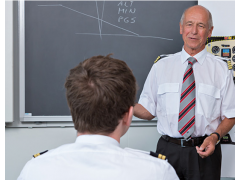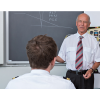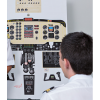SAT offers two paths to qualification as an airline pilot: the Airline Transport Pilot Licence (ATPL) course or the Multi-Crew Pilot Licence (MPL) course. An average of four courses are offered each year; and students will be assigned to one of these following a positive outcome of their aptitude assessment, and after due consultation.
The integrated ATPL course takes around 23 months and is the “classic” airline pilot training course. After completing it, the student will be issued with a Commercial Pilot Licence with instrument rating or CPL/IR. They will then receive their ATPL after completing a certain number of flight hours in service with their airline.
The integrated MPL training course is based on a new concept and also lasts 23 months. The main difference between this and the classic ATPL training is that the MPL puts an earlier focus on the multi-pilot cockpit.

Theory training
Before their cockpit training begins, students are first provided with extensive theoretical training in the classroom, via e-learning modules and through their own private study. They also conduct regular self-assessments here to monitor their progress: while our experienced instructors are on hand to offer assistance and support throughout the training process, self-responsibility and a keen sense of their own strenghts and weaknesses are essential to any student's pilot training success.
The language of the instruction in SAT's classrooms and simulators is German. The e-learning modules are in English.
The topics covered in the first seven-week phase of theory training are:
aircraft general knowledge
aviation law
flight planning and monitoring
general navigation
human performance and limitations
instrumentation
mass and balance
meteorology
performance
principles of flight
radio navigation
VFR communications
After seven weeks of basic flight training, the student will be back in the classroom for their second phase of theory training. This lasts about 17 weeks in total, and is split into two sub-phases.
The first sub-phase, which extends over four weeks, is largely spent individually further developing the knowledge gained in the basic theory course. This is accompanied by further classroom theory training.
For the other 13 weeks the focus is on conveying further knowledge that a commercial pilot will require. In addition to revisiting the topics of the first theory phase, this also includes operational procedures and radio navigation. All the theoretical knowledge acquired is put immediately into practice on the Flight Navigation Procedure Trainer (FNPT II) simulator. The work here focuses on practising the radio communications required for instrument flight rules (IFR) operations, and is concluded with a practical examination.
In the third and final 12-week theory phase, the students are prepared for their official examinations to obtain their ATPL or MPL. Following these exams, the students have eight weeks to write their diploma paper and prepare their presentation of the same.
Flight training
The student’s visual flight rules (VFR) practical flight training is held at Grenchen Airport in Northwest Switzerland. The training is conducted on our fleet of single-engined Diamond DA40NG aircraft, and lasts between six and seven weeks.
Phase 1 of this VFR flight training consists of around 14 flights. The focus here is on such topics as a general introduction to flight fundamentals, effects around the axis, slow flight and stalls, and circuits. The training is concluded with a progress test.
For the first part of Phase 2 of this flight training, the emphasis is on navigation flight and flying circuits at other aerodromes, along with the first emergency training and power-idle landings. This, too, is concluded with a progress test.
The second part of Phase 2 begins with the student’s first solo flight. This is later followed by cross-country flights within Switzerland and beyond. A so-called Basic VFR Mastery Test brings this flight phase to an end.
After mastering the basics of VFR flight, the student must next learn how to fly an aircraft and maintain their orientation using their instruments and displays. The first step here is around 13 weeks of basic training in Zurich in instrument flight rules or IFR flight. This consists of 22 theory lessons and 15 two-hour simulator sessions on our Diamond DA42 FNPT II simulators, including extensive briefings to discuss the goals and the content of each of the sessions concerned.
As the simulator training progresses, the situations increase in complexity to include such topics as the influence of wind, NDB ( non-directional beacon ) and VOR ( VHF omnidirectional range ) approaches, the use of GPS and what to do should an engine fail. Detailed observations are made throughout each session, and these are analyzed together with the student in the subsequent debriefing. This training block is also concluded with a progress test.
In view of the ideal flying conditions that the location offers, the following 14 weeks are spent conducting VFR and IFR flights out of Vero Beach in Florida in the USA. In addition to its favourable weather, the region also offers a wide range of training aerodromes with short approach paths. These flights are performed on Piper Warrior and finally, to obtain the multi-engine piston (MEP) rating, a twin-engined Piper Seminole aircraft. Students also take their practical Commercial Pilot Licence (CPL) examination while at the Vero Beach facility.
After this, the student will spend around five weeks “Europeanizing” their IFR training (including a further practical examination to obtain their instrument rating) back in Grenchen, flying our Diamond DA42 aircraft.
Multi Crew Cooperation MCC
Multi-crew cooperation (MCC) training is specifically designed to promote collaboration within the cockpit by providing both theoretical and practical training in communications, decision-making, teamwork and leadership skills. The training is conducted by various means, including integrated procedure trainers or IPTs on which the course content can be interactively conveyed. All the wordings, procedures and workflows here correspond exactly to those used by SWISS in its flight operations, to familiarize the student as early as possible with their future employer’s working practices and underlying operating philosophy.






